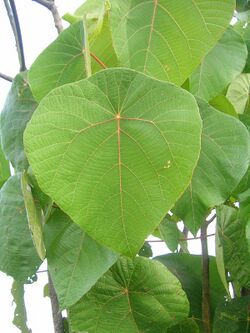Biology:Macaranga peltata
| Macaranga peltata | |
|---|---|

| |
| Scientific classification | |
| Kingdom: | Plantae |
| Clade: | Tracheophytes |
| Clade: | Angiosperms |
| Clade: | Eudicots |
| Clade: | Rosids |
| Order: | Malpighiales |
| Family: | Euphorbiaceae |
| Genus: | Macaranga |
| Species: | M. peltata
|
| Binomial name | |
| Macaranga peltata Roxb. Mueller
| |
| Synonyms | |
| |
Macaranga peltata is a plant found in northern Thailand, Sri Lanka and India . It is one of the most widely occurring early successional woody species in Sri Lanka, specially in low country wet zone.[1] Some of the many common names include kenda - කැන්ද or kanda in Sri Lanka and chandada in India.[2]
Description
It is a resinous tree, up to 10 metres (33 ft) tall. Young parts are velvet hairy. Leaves measure 20 to 50 centimetres (7.9 to 19.7 in) by 12 to 21 centimetres (4.7 to 8.3 in), are alternately arranged, circular or broadly ovate, entire or minutely dentate, and palmately 9-nerved. The leaf stalk is attached on the lower surface of the leaf, not on the base.
Yellow-green flowers occur in long panicles in leaf axils in the months of January to February. Male flowers are minute, numerous, and clustered in the axils of large bracts. One round, black seed is in a spherical capsule 4 to 5 mm across.
Ecology
Mallotus tetracoccus is a pioneer or early-successional or early-secondary[3] tree species more common in forest edges, clearings, and secondary forests than in mature forest interiors. Ecophysiological studies indicate that Macaranga peltata shows a combination of high quantum use efficiency of photosynthetic system (Fv/Fm) and relative growth rates under higher light conditions, similar in pattern to other pioneer species such as Mallotus tetracoccus.[3]
Uses
Kenda leaves are commonly used for flavoring in Sri Lanka. Halapa dough is often flattened on a kenda leaf to soak in the flavor.[4] Kenda leaves are used to wrap jaggery and other sweetmeats.[5]
Today the major use of Macranga peltata is for making wooden pencils and in the plywood industry. Kollam produces 75 to 100 truck loads of pencil slats.[citation needed]
References
- ↑ K. K. I. U. Aruna Kumara; U. Wickramasinghe. "Forestry and Environment Symposium 2000, Sri Lanka: Studies on Dormancy and Germination Dynamics of Macranga Peetata [sic (Kanda) An Early Successional Species"]. http://forestry2000.blogspot.com/2006_10_01_archive.html. Retrieved 2009-12-30.
- ↑ "Macaranga peltata - Chandada". http://www.flowersofindia.net/catalog/slides/Chandada.html. Retrieved 2009-12-30.
- ↑ 3.0 3.1 Sreejith, K. A. 2005. Ecological and Ecophysiological studies on the successional status of tree seedlings in tropical wet evergreen and semi-evergreen forests of Kerala. PhD Thesis, Forest Research Institute, Dehra Dun. 148 pages.
- ↑ "Na2EDTA Enhances the Absorption of Iron and Zinc from Fortified Rice Flour in Sri Lankan Children". Nuclear Medicine Unit, Faculty of Medicine, University of Ruhuna, Galle, Sri Lanka and U.S. Department of Agriculture/ARS Children's Nutrition Research Center, Department of Pediatrics, Baylor College of Medicine and Texas Children's Hospital. http://jn.nutrition.org/cgi/content/full/134/11/3031. Retrieved 2009-12-30.
- ↑ Sri Bharathie, K.P.. "Non-Wood Forest products in Asia". Regional Office for Asia and the Pacific (RAPA), Food and Agricultural Organization of the United Nations, Rapa Publication 1994. http://www.fao.org/docrep/X5334e/x5334e0a.htm. Retrieved 2009-12-30.
Wikidata ☰ Q3595172 entry
 |


